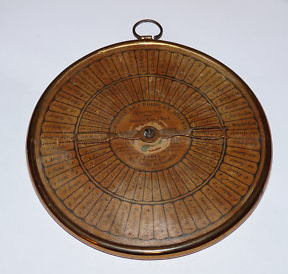
1790–1810 Instrument de calcul / Conversion Boussole des poids et mesure
Conversion des Aunes usuelles en mètres par Gabrielle CHAIX, Paris, A. Pinson et Cie, Rue Vieille du Temple Diamètre : 9 cm Porte le n° (de série ?) N° 2 écrit à l’encre
This converts the pre-metric ancien measure of Aunes (4 feet) to metres. The placing of it in 1790–1810 derives from the fact that that Pinson - the maker on the instrument - was an optician during years 1800–1815. CNAM(Conservatoire national des arts et métiers) owns instruments from him. CHAIX, the printer, is thus not likely to be Napoleon CHAIX of 1840–50 involved in printing manuals for arithmometers, but his father. In a Museum in Geneve we find: Acquisition Inv. 1268 Métrologie «Boussole des poids et mesures» (fig. 42) Carton, laiton Gabriel Chaix, Paris, fin xvme-début xixe siècle 0,6 x diam. 9 cm Don de l’Institut de physique, Genève Inv. 1 177 1
[The aune (ell), used to measure cloth, was defined as 120 centimetres, and divided into the demi aune (half an ell) and the tiers aune (third of an ell). It was 1.3% larger than l’aune de Paris (1.1848 m) and 5.0% larger than its English counterpart (45 inches).[Thierry Sabot (1 October 2000). “Les poids et mesures sous l’Ancien Régime [The weights and measures of the Ancien Régime]” (in French). histoire-genealogie.]2
1 Valéry Monnier, private communication (↑)
2 http://en.wikipedia.org/wiki/Mesures_usuelles (↑)
Pages linked to this page
 This work by Jim Falk is licensed under a Creative Commons Attribution-NonCommercial-NoDerivs 3.0 Unported License Click on the logo to the left to see the terms on which you can use it.
This work by Jim Falk is licensed under a Creative Commons Attribution-NonCommercial-NoDerivs 3.0 Unported License Click on the logo to the left to see the terms on which you can use it.